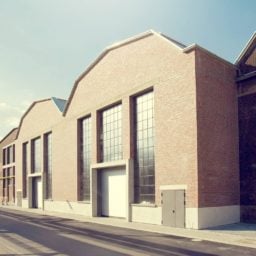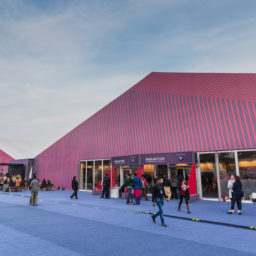“Oh, that? I guess I read about it, but I didn’t really think anything of it,” said a dealer at Art Düsseldorf’s third edition. One may have thought asking about the impact of Art Basel’s parent company, MCH Group, selling its stake of the fair would provoke more of a reaction. But I was mistaken: In the Rhineland, it was business as usual on preview day of the third edition of this regional, contemporary art-focused fair. Bygones be bygones.
In fact, it seems that MCH Group’s dramatic pull-out from its regional fair portfolio in May says more about the Basel giant than it does about Art Düsseldorf and the sustainability of the small art-fair business. Seriously—nobody cares.
On the fair floor yesterday, any change was close to indiscernible except, maybe, for the presence of Sandy Angus, the businessman who bought MCH Group’s 25 percent stake in Art Düsseldorf along with his business partner Tim Etchells. Angus could be spotted looking relaxed and chitchatting with dealers. The co-founder of ART HK, which MCH Group supersized into Art Basel Hong Kong in 2013, owns a strong portfolio of fairs in Asia, including Taipei Dangdai and the India Art Fair, along with Sydney Contemporary in Australia.
Art Düsseldorf’s amiable director, Walter Gehlen, says he hopes Angus and Etchells’s presence will draw collectors from Asia—and it seems to be working. After the Rhineland fair organized a dinner in Tokyo earlier this fall, Asian collectors including Daisuke Miyatsu (once dubbed the Japanese Herbert Vogel) were spotted roaming the aisles.
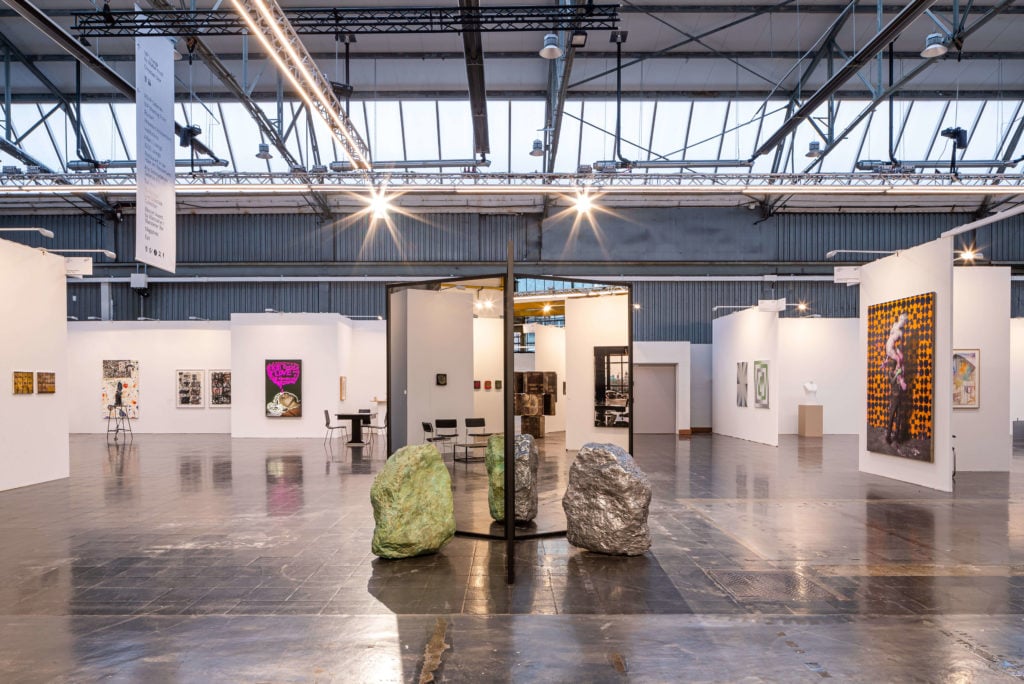
Art Düsseldorf 2019. Skulpturenplatz, König Galerie Alicja Kwade, Absorption (Dolomit) (2018). © Sebastian Drüen
A Different Pace
Everyone Artnet News spoke to on preview day seemed at ease with Rhineland’s slow-burn sales. “Collectors come on Thursday, then maybe again on Friday or Saturday, and close deals on Sunday,” a gallerist at Sies + Höke said. The Düsseldorf gallery, which represents heavy-hitting German artists such as Jonathan Meese, sold several paintings priced between €28,000 to €50,000 ($30,000 to $55,000) to private Rhineland collections.
Unusually, the gallery had three booths at the fair, two of which were collaborations with newcomers from abroad. One was especially eye-catching: In partnership with Mendes Wood DM of Brussels and Proyectos Ultravioleta from Guatemala, the German dealers showed an installation by an artist they all represent, Naufus Ramírez-Figueroa. Their joint booth replicated the Guatemalan artist’s haunting presentation at the New Museum in New York in 2018, green wall and all. (Works were on offer from $12,000 to $33,000.)
At Galerie Hans Mayer, another major player in the Düsseldorf art scene, a booth packed with work largely by German artists was busy on opening day. In the words of a dealer on the stand, “This isn’t like Art Basel. Collectors shop differently.” And because booths are relatively cheaper to rent—small galleries pay as little as €2,000—dealers can afford to play a bit more: from Hans Mayer’s back room, one could catch a glimpse of Naomi Campbell, Linda Evangelista, and Cindy Crawford in the form of a large-format photograph of the supermodels by the late German fashion photographer Peter Lindbergh. “Dear Hans, this is for you,” the photographer wrote just to the left of Christy Turlington’s belt loop. The autograph print, once a gift, was on sale for €200,000 ($220,000).

Jonathan Meese’s paintings and carpet installation at Sies + Höke’s solo booth at Art Düsseldorf. © Sebastian Drüen
But the news buzzing around the fair was that Hans Mayer will be merging under one roof with a gallery run by his son, Max Mayer. He is also an art dealer, albeit with a very different, more contemporary program. Next summer, they will open together at the elegant Schmela Haus in Düsseldorf.
German art seemed to be drawing the most attention, judging by the flow of VIPs on preview day. At Schönewald Fine Arts, also from Düsseldorf, a dynamic booth includes works by household names like Gerhard Richter, Georg Baselitz, and Rosemarie Trockel. At KOW from Berlin and Madrid, a large wall sculpture by Henrike Naumann was acquired by Düsseldorf’s Museum Kunstpalast for €25,000 ($27,000).
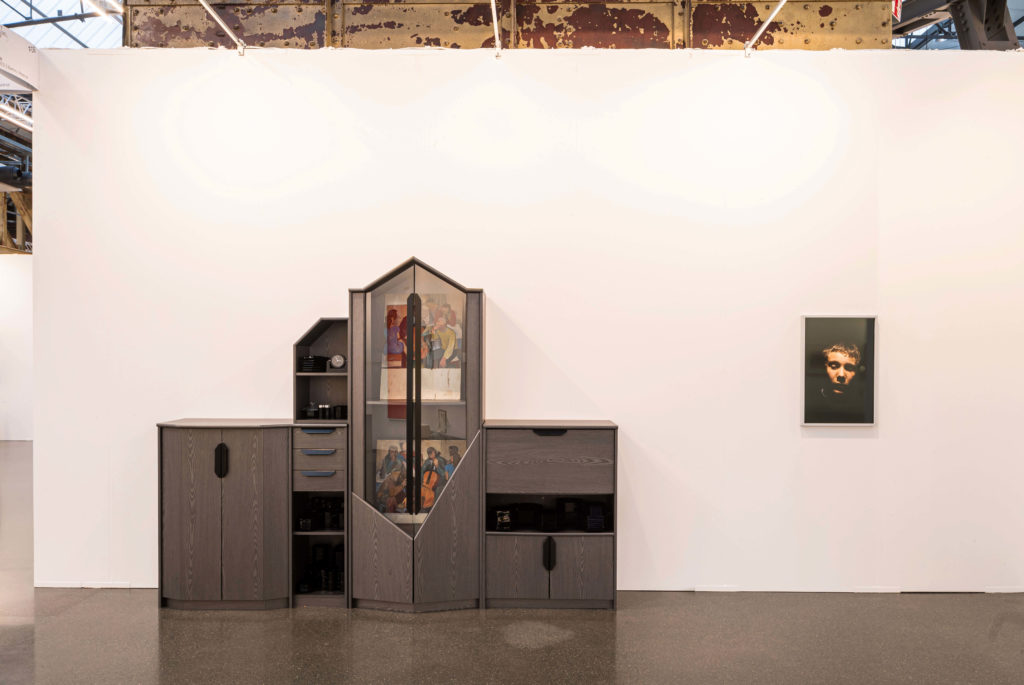
DDR Noir (2019) on view at KOW’s booth at Art Düsseldorf. © Sebastian Drüen
Basel vs. Düsseldorf
As I asked how sales were going—usually in vain—the difference between Basel and Düsseldorf was continually underlined. The Rhineland’s collectors are very serious list-makers, dealers said. They don’t snap things up, but they do buy consistently. The younger galleries repeated the same line, albeit more nervously. But the point begs an interesting question: Do regional art fairs need to be internationally aspirational? Or are they better off pinning their efforts on their local scene which, in the case of Düsseldorf, has a great cocktail of institutions, galleries, and collectors to boast already?
The fair’s director Walter Gehlen seems to be aware of the need to flaunt the region’s unique assets: wealthy types that have art collecting in their genes. Thanks to his invitation, a group of major collectors with spaces of their own have a booth this year. The Julia Stoschek Collection, KAI 10 Arthena Foundation, Langen Foundation, and the Philara Collection established a new exhibiting initiative called Rhineland Independent. At the fair, they presented a solo project by the feminist collective Guerrilla Girls.
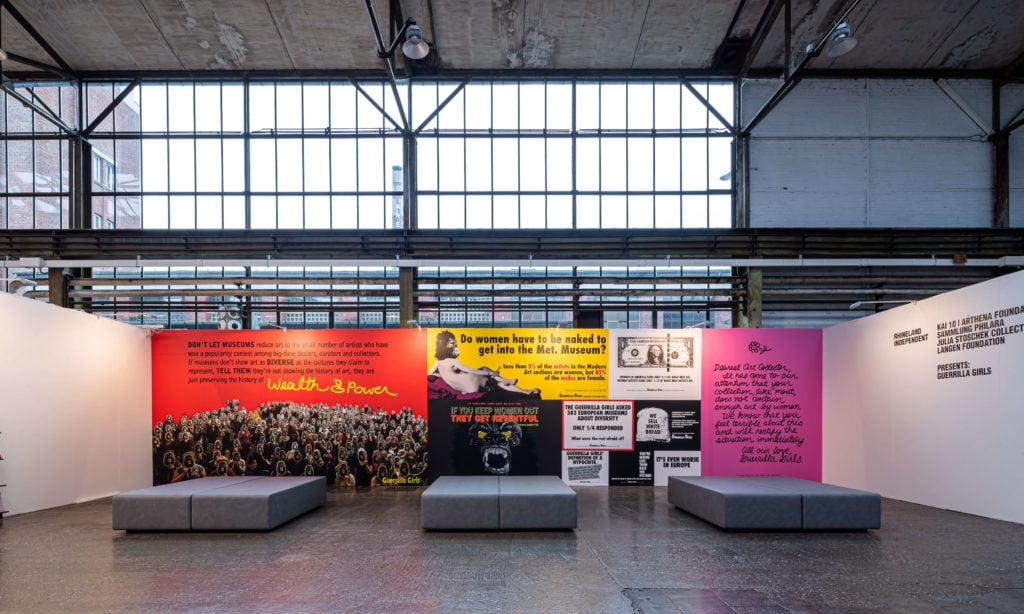
Guerrilla Girls star at Rhineland Independent’s booth at Art Düsseldorf. © Sebastian Drüen
Local Power
“Walter looks after the artists and the galleries so well, I have never seen that at another fair,” said Karla Zerressen, director of the Langen Foundation, acknowledging the “perfectly sized” fair that is “not too big, not too small.” This year, there are just over 100 exhibitors. She bought a piece of wearable art from Paloma Varga Weisz, a German artist based in Düsseldforf, at König Galerie. Zerressen admits that Rhineland collectors do tend to shop for Rhineland artists.
This might prove to be an ongoing challenge for out-of-town dealers. A gallery-share initiative from Warsaw, Friend of a Friend, was given an enviably large booth for free for its group presentation that included many international and Polish artists. But they seemed concerned that collectors were only visiting local dealers they appeared to already know. Nevertheless, their presence (alongside with Rhineland Independent) is a testament to the spry art fair’s desire to create supportive partnerships as a way forward.
Though the fair seems to have ambitions to build its international profile, that doesn’t seem to be where its strong suit lies. Does the art world we need another “international” art fair? Or is Düsseldorf at its best focusing on the power of its regional profile as a way to draw interested international shoppers? Put another way, maybe the Rhineland doesn’t need a Swiss-style fair. Maybe it’s Switzerland that needs the Rhineland instead.







